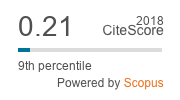Assumir o Comando no Trabalho
Evidências de Validade da Versão Brasileira da Escala
Mots-clés :
Validação, Proatividade, Assumir o comando da mudançaRésumé
Esta pesquisa teve como objetivo explorar evidências de validade da versão brasileira da escala de assumir o comando da mudança. Utilizou-se uma amostra de 197 trabalhadores brasileiros e os dados foram coletados via questionário online. Testou-se a estrutura de mensuração da escala, a relação com variáveis da rede nomológica e com o comportamento proativo de expressar ideias e sugestões. Os dados sugerem que o construto é unifatorial e confavelmente medido no Brasil com oito dos dez itens da escala original. A confrmação das correlações esperadas com as variáveis da rede nomológica sugerem evidências de validade de construto, assim como o teste do modelo hipotetizado que inclui o outro comportamento proativo,
que indicou evidências de validade concorrente e discriminante.
Palavras-chave: validação, proatividade, assumir o comando da mudança
Téléchargements
Références
Ashford, S. J. (1986). Feedback-seeking in individual adaptation: A
resource perspective. Academy of Management Journal, 29(3),
”“487. doi:10.2307/256219
Ashford, S. J., & Black, J. S. (1996). Proactivity during
organizational entry: The role of desire for control. Journal
of Applied Psychology, 81(2), 199”“214. doi:10.1037/0021-
81.2.199
Bateman, T. S., & Crant, J. M. (1993). The proactive component
of organizational behavior: A measure and correlates. Journal
of Organizational Behavior, 14(2), 103”“118. doi:10.1002/
job.4030140202
Bateman, T. S., & Crant, J. M. (1999). Proactive behavior: Meaning,
impact, recommendations. Business Horizons, 42(3), 63”“70.
doi:10.1016/S0007-6813(99)80023-8
Byrne, B. M. (2009a). Bootstrapping as an aid to nonnormal data.
In Structural equation modeling with AMOS: Basic concepts,
applications, and programming (2nd ed., pp. 329”“352). New
York, NY: Routledge.
Byrne, B. M. (2009b). Testing for the factorial validity of a
theoretical construct (first-order CFA model). In Structural
equation modeling with AMOS: Basic concepts, applications,
and programming (2nd ed., pp. 53”“95). New York, NY.
Crant, J. M. (2000). Proactive behavior in organizations.
J o u r n a l o f M a n a g e m e n t , 2 6 ( 3 ) , 4 3 5 ”“ 4 6 2 .
doi:10.1177/014920630002600304
Fornell, C., & Larcker, D. F. (1981). Evaluating structural equation
models with unobservable variables and measurement
error. Journal of Marketing Research, 18(1), 39”“50.
doi:10.2307/3151312
Grant, A. M., & Ashford, S. J. (2008). The dynamics of proactivity
at work. Research in Organizational Behavior, 28, 3”“34.
doi:10.1016/j.riob.2008.04.002
Grant, A. M., Gino, F., & Hofmann, D. A. (2011). Reversing
the extraverted leadership advantage: The role of employee
proactivity. Academy of Management Journal, 54(3), 528”“550.
doi:10.5465/AMJ.2011.61968043
Grant, A. M., Parker, S. K., & Collins, C. (2009). Getting credit
for proactive behavior: Supervisor reactions depend on what
you value and how you feel. Personnel Psychology, 62, 31”“55.
doi:10.1111/j.1744-6570.2008.01128.x
Hu, L., & Bentler, P. M. (1999). Cutoff criteria for fit indexes in
covariance structure analysis: Conventional criteria versus
new alternatives. Structural Equation Modeling, 6(1), 1”“55.
doi:10.1080/10705519909540118
Idaszak, J. R., & Fritz, D. (1987). A revision of the Job Diagnostic
Survey: Elimination of a measurement artifact. Journal
of Applied Psychology, 72(1), 69”“74. doi:10.1037/0021-
72.1.69
LePine, J. A., & Van Dyne, L. (1998). Predicting voice behavior in
work groups. Journal of Applied Psychology, 83(6), 853”“868.
doi:10.1037/0021-9010.83.6.853
Mackenzie, S. B., Podsakoff, P. M., & Podsakoff, N. P. (2011).
Challenge-oriented organizational citizenship behaviors and
organizational effectiveness: Do challenge-oriented behaviors
really have an impact on the organization’s bottom line?
Personnel Psychology, 64(3), 559”“592. doi:10.1111/j.1744-
2011.01219.x
Miles, J., & Shevlin, M. (2001). Applying regression & correlation:
A guide for students and researchers. London: SAGE
Publications Ltd.
Morrison, E. W., & Phelps, C. C. (1999). Taking charge at work:
Extrarole efforts to initiate workplace change. Academy of
Management Journal, 42(4), 403”“419. doi:10.2307/257011
Parker, S. K. (1998). Enhancing role breadth self-efficacy:
The roles of job enrichment and other organizational
interventions. Journal of Applied Psychology, 83(6), 835”“852.
doi:10.1037/0021-9010.83.6.835
Parker, S. K., & Collins, C. G. (2010). Taking stock: Integrating
and differentiating multiple proactive behaviors. Journal of
Management, 36(3), 633”“662. doi:10.1177/0149206308321554
Parker, S. K., Williams, H. M., & Turner, N. (2006). Modeling the
antecedents of proactive behavior at work. Journal of Applied
Psychology, 91(3), 636”“652. doi:10.1037/0021-9010.91.3.636
Pilati, R., & Laros, J. A. (2007). Modelos de equações estruturais
em psicologia: Conceitos e aplicações. Psicologia: Teoria e
Pesquisa, 23(2), 205”“216.
Seibert, S. E., Crant, J. M., & Kraimer, M. L. (1999). Proactive
personality and career success. Journal of Applied Psychology,
(3), 416”“427. doi:10.1037/0021-9010.84.3.416
Thomas, J. P., Whitman, D. S., & Viswesvaran, C. (2010).
Employee proactivity in organizations: A comparative
meta-analysis of emergent proactive constructs. Journal of
Occupational and Organizational Psychology, 83(2), 275”“300.
doi:10.1348/096317910x502359
Thompson, B. (2004a). Confirmatory factor analysis decision
sequence. In Exploratory and confirmatory factor analysis:
Understanding concepts and applications (pp. 109”“132).
Washington, DC: American Psychological Association.
Thompson, B. (2004b). Testing model invariance. In Exploratory
and confirmatory factor analysis: Understanding concepts
and applications (pp. 153”“162). Washington, DC: American
Psychological Association.
Tornau, K., & Frese, M. (2013). Construct clean-up in proactivity
research: A meta analysis on the nomological net of workrelated
proactivity concepts and their incremental validities.
Applied Psychology: An International Review, 62(1), 44”“96.
doi:10.1111/j.1464-0597.2012.00514.x
Urbina, S. (2007). Fundamentos em validade. In Fundamentos de
Testagem Psicológica (pp. 155”“212). Porto Alegre: Artmed.
Van Dyne, L., & LePine, J. A. (1998). Helping and voice
extra-role behaviors: Evidence of construct and predictive
validity. Academy of Management Journal, 41(1), 108”“119.
doi:10.2307/256902



